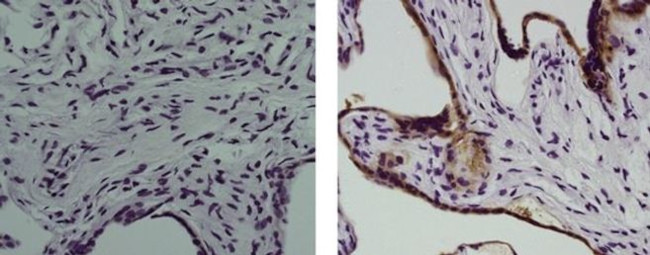Search Thermo Fisher Scientific
Invitrogen
Placental Alkaline Phosphatase Monoclonal Antibody (8B6), eBioscience™
FIGURE: 1 / 1
Placental Alkaline Phosphatase Antibody (14-9870-82) in IHC (P)

Product Details
14-9870-82
Species Reactivity
Host/Isotype
Class
Type
Clone
Conjugate
Form
Concentration
Purification
Storage buffer
Contains
Storage conditions
Shipping conditions
RRID
Product Specific Information
Description: The monoclonal antibody 8B6 recognizes human Placental Alkaline Phosphatase (PLAP), a 130 (or 130 with 65 kDa) enzyme expressed by placental syncytiotrophoblastoid cells. This enzyme has slightly different enzyme kinetics from other phosphatases. PLAP can be found anchored to the plasma membrane in addition to the cytoplasm. Expression is found in several germ line cancers; ovarian and testicular. Expression is also present in human embryonic stem cells and bone marrow-derived mesenchymal stromal cells.
This 8B6 antibody reacts with both the Regan and Nagao isozymes.
Applications Reported: This 8B6 antibody has been reported for use in immunohistochemical staining of frozen (IHC-F) and formalin-fixed paraffin embedded (IHC-P) tissue, and ELISA.
Applications Tested: This 8B6 antibody has been tested by immunohistochemistry on formalin-fixed paraffin embedded (FFPE) human placenta with trypsin digestion. This antibody can be used at less than or equal to 5 µg/mL. It is recommended that the antibody be carefully titrated for optimal performance in the assay of interest.
Purity: Greater than 90%, as determined by SDS-PAGE.
Aggregation: Less than 10%, as determined by HPLC.
Filtration: 0.2 µm post-manufacturing filtered.
Target Information
Placental Alkaline Phosphatase plays an important role in the regulation of specific inflammatory disease processes. There are at least four distinct but related alkaline phosphatases: intestinal, placental, placental-like, and liver/bone/kidney for this form of alkaline phosphatase have been well characterized. Placental Alkaline Phosphatase reacts with a membrane-bound isoenzyme (Regan and Nagao type) of Placental Alkaline Phosphatase (PLAP) occurring in the placenta during the 3rd trimester of gestation. Placental Alkaline Phosphatase is useful in the identification of testicular germ cell tumors. Unlike germ cell tumors, PLAP-positive somatic cell tumors uniformly express epithelial membrane antigen (EMA). A proposed function of Placental Alkaline Phosphatase is matrix mineralization; however, mice that lack a functional form of this enzyme show normal skeletal development. Placental Alkaline Phosphatase has been linked directly to hypophosphatasia, a disorder that is characterized by hypercalcemia and includes skeletal defects. The character of hypophosphatasia can vary, however, depending on the specific mutation since this determines age of onset and severity of symptoms.
For Research Use Only. Not for use in diagnostic procedures. Not for resale without express authorization.
References (0)
Bioinformatics
Protein Aliases: Alkaline phosphatase placental type; Alkaline phosphatase Regan isozyme; Alkaline phosphatase, placental type; alkaline phosphomonoesterase; Alp1; DOA1; FLJ11281; FLJ40094; FLJ61142; FLJ93059; Germ-cell alkaline phosphatase; glycerophosphatase; HOPS; MGC161443; MGC167935; nagao Isozyme; P PLAP; PLAA; Placental alkaline phosphatase 1; placental heat-stable alkaline phosphatase; PLAP-1; PLAP1; Regan isozyme; TNAP; TNSALP
Gene Aliases: ALP; ALPP; PALP; PLAP; PLAP-1
UniProt ID: (Human) P05187
Entrez Gene ID: (Human) 250

Performance Guarantee
If an Invitrogen™ antibody doesn't perform as described on our website or datasheet,we'll replace the product at no cost to you, or provide you with a credit for a future purchase.*
Learn more
We're here to help
Get expert recommendations for common problems or connect directly with an on staff expert for technical assistance related to applications, equipment and general product use.
Contact tech support
